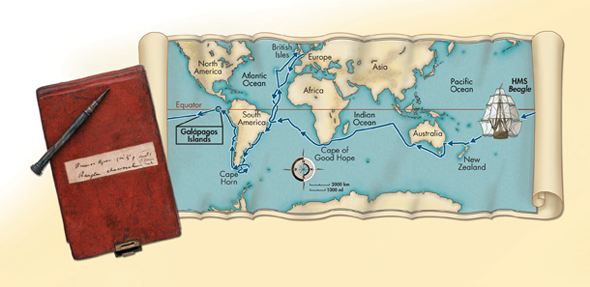Observations Aboard the Beagle
 What three patterns of biodiversity did Darwin note?
What three patterns of biodiversity did Darwin note?
A collector of bugs and shells in his youth, Darwin had always been fascinated by biological diversity. On his voyage, the variety and number of different organisms he encountered dazzled him. In a single day's trip into the Brazilian forest, he collected 68 species of beetles, and he wasn't particularly looking for beetles!
Darwin filled his notebooks with observations about the characteristics and habitats of the different species he saw. But Darwin wasn't content just to describe biological diversity. He wanted to explain it in a scientific way. He kept his eyes and mind open to larger patterns into which his observations might fit. As he traveled, Darwin noticed three distinctive patterns of biological diversity: (1) Species vary globally, (2) species vary locally, and (3) species vary over time.
Species Vary Globally Darwin visited a wide range of habitats on the continents of South America, Australia, and Africa and recorded his observations. For example, Darwin found flightless, ground-dwelling birds called rheas living in the grasslands of South America. Rheas look and act a lot like ostriches. Yet rheas live only in South America, and ostriches live only in Africa. When Darwin visited Australia's grasslands, he found another large flightless bird, the emu.  Darwin noticed that different, yet ecologically similar, animal species inhabited separated, but ecologically similar, habitats around the globe.
Darwin noticed that different, yet ecologically similar, animal species inhabited separated, but ecologically similar, habitats around the globe.
Darwin also noticed that rabbits and other species living in European grasslands were missing from the grasslands of South America and Australia. What's more, Australia's grasslands were home to kangaroos and other animals that were found nowhere else. What did these patterns of geographic distribution mean? Why did different flightless birds live in similar grasslands across South America, Australia, and Africa, but not in the Northern Hemisphere? Why weren't there rabbits in Australian habitats that seemed ideal for them? And why didn't kangaroos live in England?
Quick Lab
GUIDED INQUIRY
Darwin's Voyage
1 Using a world map and Figure 16–1, count the number of lines of 10° latitude the Beagle crossed.
2 Using the biome map from Chapter 4 as a reference, identify three different biomes Darwin visited on his voyage.
Infer How did the geography of Darwin's voyage give him far greater exposure to species variability than his fellow scientists back home had?
Analyze and Conclude

FIGURE 16–1 Darwin's Voyage On a five-year voyage aboard the Beagle, Charles Darwin visited several continents and many remote islands. Draw Conclusions Why is it significant that many of the stops the Beagle made were in tropical regions?
ddTable of Contents
- Formulas and Equations
- Applying Formulas and Equations
- Mean, Median, and Mode
- Estimation
- Using Measurements in Calculations
- Effects of Measurement Errors
- Accuracy
- Precision
- Comparing Accuracy and Precision
- Significant Figures
- Calculating With Significant Figures
- Scientific Notation
- Calculating With Scientific Notation
- Dimensional Analysis
- Applying Dimensional Analysis




